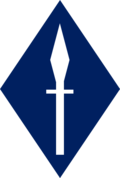1st Signal Brigade (United Kingdom)
| 1st Signal Brigade | |
|---|---|
 1st Signal Brigade Formation Sign | |
| Active | 1995 – present |
| Country |
|
| Branch |
|
| Type | Signals |
| Role | Communications brigade |
| Size | Brigade |
| Part of | Force Troops Command |
| Garrison/HQ |
Imjin Barracks, Innsworth, UK formerly Rhine Garrison, Germany |
| Engagements | Bosnian War |
1st (United Kingdom) Signal Brigade is based in Gloucester and commands, prepares and generates forces which are held at high states of readiness to support current and future military operations all over the world. The Brigade delivers robust and resilient Command Support, Communications Information Systems and Real Life Support to formations including the NATO Allied Rapid Reaction Corps (ARRC), the Joint Rapid Reaction Force, the Vanguard Aviation Force, the Air Assault Task Force and the Vanguard Field Hospital.
History
The brigade was formed on 1 January 1995 and saw action in Bosnia and Herzegovina under Brigadiers Tony Raper and James Shaw in 1995/96 as part of IFOR and, later, in 1999 as part of KFOR.[1] Under Army 2020, 1st (United Kingdom) Signal Brigade was reorganized into four specialist units, some of which are equipped with some of the most up to date communications technology in the British Army.[2]
Role
Each unit is trained to carry out a unique and challenging role in support of the overall brigade mission and is prepared to deploy at short notice anywhere in the world.[2]
- 22nd Signal Regiment, based in Stafford and Innsworth, deliver Information Communication Systems to the NATO Allied Rapid Reaction Corps Headquarters at their permanent base in Gloucester and when deployed on exercises or operations overseas anywhere across the globe.
- ARRC Support Battalion, based in Innsworth, provide a bespoke and resilient staff working environment which can be deployed anywhere in the world at short notice to allow the NATO Allied Rapid Reaction Corps Headquarters to carry out their command role in any type of armed conflict. The Battalion also provides the crucial real life support and protection that enables the headquarters to focus on its role.
- 30th Signal Regiment, based in Bramcote, is a busy, high readiness unit that provides bespoke communications support to the Joint Rapid Reaction Force, Vanguard Aviation Force, Air Assault Task Force, Vanguard Field Hospital and Allied Rapid Reaction Force Headquarters. The Regiment has small specialist teams prepared to deploy to trouble spots worldwide at a moment's notice to provide communications for military planners and liaison staff. 30th Signal Regiment also forms the headquarters for the Queen's Gurkha Signals.
- 299 Signal Squadron (Special Communications), which is a small specialist unit that provides communications and command support direct to the Foreign and Commonwealth Office overseas.
Commanders
The following have commanded 1st Signal Brigade since its inception as a separate command:[3]
- Brigadier Tony Raper, Apr 1995 - Jan 1996
- Brigadier James Shaw, Jan 1996 - May 1998
- Brigadier Robert Baxter, May 1998 - Mar 2000
- Brigadier David McDowall, Mar 2000 - Jan 2002
- Brigadier Tim Inshaw, Jan 2002 - Jan 2004
- Colonel David Hargreaves, Jan - Mar 2004
- Brigadier Neil Couch, Mar 2004 - Sep 2005
- Brigadier Nicholas Pope, Sep 2005 - Dec 2007
- Brigadier Andy Bristow, Dec 2007 - Jul 2008
- Brigadier Ivan Hooper, Jul 2008 - Nov 2010
- Brigadier David Robson, Nov 2010 - Sep 2012
- Brigadier Tim Carmichael, Sep 2012 - Aug 2014
- Brigadier Sharon Nesmith, Aug 2014–2016
- Brigadier Paul R. Griffiths 2016-present
References
- ↑ Lord, Cliff (2014). "The Royal Corps of Signals: Unit Histories of the Corps (1920-2001), and Its Antecedents". Helion & Co. p. 304. ISBN 978-1874622925.
- 1 2 "Army 2020 Report" (PDF). Retrieved 20 December 2014.
- ↑ Senior Army Appointments as at Jun 2015. Retrieved 13 Oct 2017.
External links
- HQ 1 Signal Brigade homepage at www.army.mod.uk